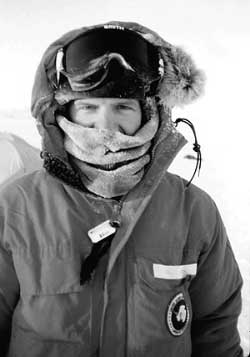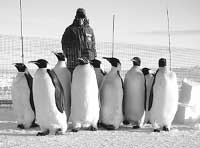Alumni Profile
 |
|
This alum's work takes him to environmental extremes
By Mary K. Miller
Photographs courtesy of Paul Ponganis
Here's a typical workday in November for alumnus Paul Ponganis, MD, PhD: He wakes up, crawls out of his tent to brilliant Antarctic sunshine, grabs a cup of coffee and checks on his study subjects, 10 plump and healthy Emperor penguins. During the course of the day, he and his fellow biologists from Scripps Institution at UC-San Diego might bring one of the birds into their lab, place a homemade anesthesia mask over its long beak and, after the gas takes hold, implant an ECG monitor under its skin or attach a backpack for a video camera. After a quick recovery, the penguin joins its companions in a fenced yard on the sea ice, complete with two diving holes enabling the birds to go in and out of the water at will. For the rest of the day, Ponganis monitors the physiology, behavior and depth profiles of the penguins during their many foraging dives.
Here's a typical workday in May for this 1979 School of Medicine graduate: He leaves home and battles bustling San Diego traffic to arrive at Sharp Memorial Hospital, dons OR scrubs and administers anesthesia to his cardiac surgery patient amid a team of six nurses and other doctors. He may participate in several operations in a 12-hour day, during which he will monitor his patient's heart and breathing rates and make sure the patient receives enough life-giving oxygen. The surgical workload spans a wide range, from routine operations to trauma and heart transplants.
Luckily for Ponganis, the two parts of his seemingly "schizo" lifestyle as an Antarctic research biologist and private practice anesthesiologist actually complement each other.
"My work with diving animals, staying up to date on current research and the understanding I have of physiology makes me a much better clinician," he says. "My medical background provides direction for my work with diving physiology and lets me do these surgical procedures without harming the animals."
It also helps that his medical colleagues are supportive of his other line of work, which takes him away from the hospital for many months each year. "Everyone in the Anesthesia Service Medical Group loves that I do work in Antarctica," he says.
 |
|
Extreme Animals
"My medical colleagues like to hear what's going on with the penguin research and they are just amazed at the physiology of these animals and what they can do," Ponganis says.
Emperor penguins, which live in the harsh conditions of Antarctica year round, are the largest and most accomplished diving birds in the world. On a single breath of air, they can dive to 1,500 feet. During a typical dive, they stay underwater in freezing conditions for 12 minutes (the record is 22 minutes). "We're very interested in how these animals have adapted to stay underwater so long without breathing oxygen," Ponganis says. "This is something my human patients could never tolerate."
Supported by the National Science Foundation, Ponganis and his colleagues at Scripps hope that the work they do with diving animals in Antarctica contributes to a better understanding of physiology as well as to potential medical applications. Seals, whales and penguins can tolerate extreme hypoxemia, in part because high levels of myoglobin allow them to store more oxygen in their muscles, making them less dependent on blood oxygen during dives. Ponganis is investigating myoglobin gene expression in Emperor penguins, which have the highest concentrations of any species.
The ability of diving animals to survive long periods with low blood flow (ischemia) might also lead the way to better treatments for shock and stroke victims, who can suffer permanent damage when their brains and other organs are oxygen-deprived. Low oxygen levels and ischemia in humans can also lead to reperfusion injury, damage that occurs when blood flow is cut off, then restored to organs. The cellular damage is thought to arise from oxygen molecule free radicals, a reactive chemical produced as a byproduct of biological activity. Emperor penguins somehow avoid reperfusion injury despite severe organ ischemia and hypoxemia, perhaps because their organs and tissues have naturally high levels of antioxidants.
Ponganis is also researching the ability of penguins and seals to collapse their lungs during deep dives and reinflate them at the surface. Chemicals that line the lungs, called surfactants, are important in regulating surface tension and controlling this process. "We're interested in the chemical composition of surfactants and whether seals and penguins have a higher concentration in their lungs than people do," Ponganis says. "Not enough is known about surfactant function, and these animals give us a good model for studying this function in extreme conditions. This understanding could point the way to potential applications, including treatments for respiratory distress syndrome in premature infants."
Complementary Careers
It may seem unusual for an MD to branch off into research biology but for Ponganis it seems natural. He finished his doctoral dissertation in animal physiology at UC-Santa Cruz in 1976 – during his first year of medical school at Stanford.
"I was always interested in medicine, having a practice and working with people. I was also intrigued by the difference between humans and diving animals and needed a medical background to really understand the physiology."
Ponganis completed an internship and residency in anesthesia at Stanford, specializing in cardiac anesthesia. He joined the faculty there and seemed set for a solid career in academic medicine. Then, in 1983, he accepted an offer to work at Scripps with Gerald Kooyman, a leading authority on diving physiology and a pioneer in the field.
"It was a hard decision to leave, but working with Gerry was a unique opportunity," Ponganis says. "I always envisioned that I would work in both animal physiology and medicine. There was an opening in a private practice in San Diego, so this gave me the chance to do both."
Since 1983, Ponganis has been balancing the two careers, working at the hospital in between research trips to far-flung parts of the world. His research with seals and penguins has taken him to the Pribolof Islands in Alaska, Lake Baikal in Siberia, the Galapagos Islands and Antarctica where he spends three months a year studying Emperor penguins.
"These really are magnificent animals and I work in one of the most peaceful, beautiful places on earth," Ponganis says. "It's both a challenge and great fun to study these animals under natural conditions, diving in the sea. The fact that I can return from Antarctica to a private practice back home, I guess that makes my situation unique."
Comments? Contact Stanford Medicine at

